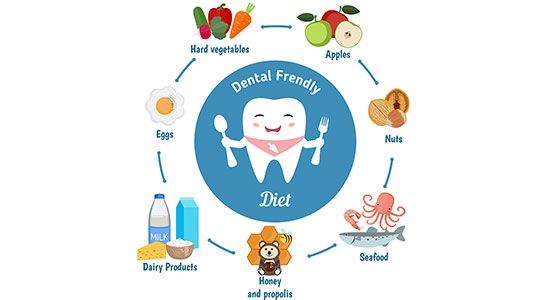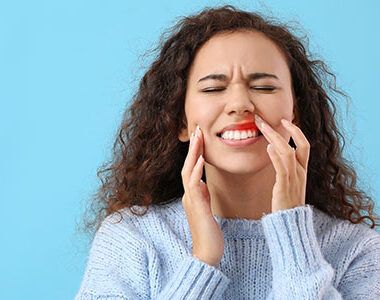Tooth-Friendly Diet: 5 Best Foods for Promoting Dental Health
By Azrung Fayaz, Doctor of Internal Medicine | MBBS, FCPS, MRCP
Last Updated on October 23rd, 2023 / Published on September 11, 2023

No one enjoys the whir of a dentist’s drill. How about replacing that sound with the crunch of foods that taste great and protect your smile?
Dental problems are shockingly common in the U.S. One in four adults has untreated dental issues.1 Moreover, almost half of Americans over 30 show signs of gum disease.2
Now, here’s the game-changer: your diet! Forget the notion that oral health is only about brushing and flossing. What you eat has a direct, proven impact on your teeth and gums.
A poor diet can lead to cavities, gum disease, and even mouth infections.3 But a balanced4 diet—rich in fruits, vegetables, whole grains and low in sugars—can be your best defense.
In this guide, we’ll dive deep into the science of how diet impacts your oral health. We’ll also spotlight the best foods and the essential nutrients, all backed by quality research. So grab your grocery list; you’re about to journey to a lifetime of healthy teeth and gums.
Unveiling Healthy Nutrients for Strong Teeth and Gums
Below, we’ve curated the best healthy nutrients to strengthen your teeth and gums. Let’s dive in.
Calcium: More Than Healthy Bones
Calcium is essential for your teeth. It strengthens the hard outer layers of your teeth, called enamel and dentin. Your teeth also need calcium when growing.5 It keeps your jawbone healthy,6 which, in turn, holds your teeth in place. Your teeth can weaken and loosen if you don’t get enough calcium.
Calcium is good for your gums, too. One study7 showed that up to 39% fewer people got gum disease when they ate more calcium-rich foods.
This is because the calcium in your saliva neutralizes the acid bacteria make in your mouth. This harmful acid can damage your gums and make holes in your teeth (called cavities or dental caries).8
Phosphorus: The Underappreciated Mineral in Oral Health
Phosphorus is also vital for strong teeth.9 For instance, chewing gum containing phosphorus reduces the risk of dental diseases.10
This is because phosphorus makes up the hard parts of your teeth11 called tooth enamel and dentin.
Like calcium, phosphorus also helps lower the acid levels12 in your mouth. Otherwise, you’d have acid erosion in your teeth.
Vitamin C: The Gum Health Guardian
Vitamin C is essential for your teeth and gums. It helps make collagen,13 a protein. The collagen helps anchor your teeth in your jaw and prevent tooth loss.
Vitamin C also helps heal wounds14 in your gums and jaw. A study15 showed patients who ate citrus fruits (containing vitamin C) healed faster after dental implants. Conversely, patients who didn’t take these fruits recovered more slowly.
Foods to Avoid and Have for Healthy Teeth
The Don’ts: The Sugar Dilemma
Sugary foods and drinks can damage your teeth and gums.16
Sugar enables harmful bacteria to boost acid production in your mouth. The acid forms a sticky layer called plaque on your teeth. Plaque buildup lets more bad bacteria stick to your teeth and make acid.
This can hurt your tooth’s outer layer, creating holes (called cavities). It can also cause gum swelling. One study17 found that too much sugar increases the risk of gum disease (i.e., periodontal disease).
What Amount of Sugar Is Too Much?
According to the World Health Organization (WHO),18 kids under two should have no sugar content. At the same time, older kids and adults should have less than 25 grams daily.
The Do’s: Fiber’s Role in a Healthy Diet for Teeth and Gums
Fiber does two good things for your mouth.19
First, fibrous foods help clean your teeth by increasing saliva flow. This flow of saliva acts like a brush to clean your mouth.
Second, fiber makes your mouth less acidic. Lower acid levels mean fewer cavities and stronger gums.
Five Healthy Foods for Your Teeth: What Research Advocates
Dairy Products: More Than a Calcium Fix
Dairy foods like milk, yogurt, and cheese are great for your teeth and gums.20 A study21 looked at 6,885 kids and teens between the ages of 2 and 17. It found that eating more than 123 grams of yogurt daily could lower the chance of getting cavities by up to 39%.
This is because dairy products:
- are rich in calcium and phosphate. These make your teeth strong.
- contain proteins (called lactoferrin and lysozyme) with antibacterial properties.22 This means they can kill cavity-causing bacteria.
- reduce acidity in your mouth. Studies23 show this reduces the chances of cavities.
Crunchy Vegetables and Fibrous Fruits: Nature’s Toothbrush
A study24 looked at how eating fruits and vegetables affects your teeth. The more fruits and veggies people ate, the better their oral health score was. Here’s why:
- Crunchy foods, like apples and carrots, make you chew a lot. Chewing stimulates saliva production.25 The increased saliva level is like a natural teeth cleaner. It takes away acid and adds suitable substances like calcium and phosphorus.
- Fresh fruits and vegetables are also rich in vitamins C and E.26 These reduce swelling in your gums and mouth.
- Fruits and vegetables contain special substances (called polyphenols).27 These can kill oral bacteria in your mouth. As a result, fruits and vegetables reduce cavities, protect the gums, and give you fresh breath.
Leafy Greens: The Green Vegetables for Healthy Gums
A study28 from Korea looked at how eating plant foods affects teeth. The study found two important things:
- People who ate more plants had fewer teeth problems.
- Eating leafy greens like spinach lowered the risk of gum disease by 26.7%
Leafy greens like spinach and kale have lots of Vitamin C. As discussed above, vitamin C is good for your teeth and gums.
Leafy greens are also rich in antioxidants.29 These substances fight off harmful chemicals called free radicals. This prevents tooth decay and gum disease (called periodontal disease).
Lastly, leafy greens make you chew a lot. They also have a lot of water content.30 The chewing and plenty of water boost saliva production. This cleans teeth surfaces and makes your mouth less acidic.
Quality Protein: Fish, Meat, and Dental Health
Lean proteins help build and repair parts of your body, including your gums and mouth. If you eat enough protein, your gums heal better and quicker.
Protein is also rich in collagen. Collagen helps anchor your teeth to your jaw. You can get collagen from lean protein sources like meat and fish. Eating these foods makes teeth healthy and more robust.
The research is clear: Protein is excellent for your gums and teeth. For example, in one study,31 people who ate fish had healthier gums and fewer dental problems.
Similarly, in another research,32 eating protein improved repair and reduced pain in patients wearing tooth braces.
Nuts and Seeds: Meal Snacks for a Healthy Mouth
Nuts and seeds like almonds contain essential elements. They have vitamins, good fats, and protein. These help make your teeth stronger and gums healthy.
Nuts and seeds33 are also sources of calcium and phosphorus. These minerals make the hard part of your teeth, called tooth enamel, even more robust.
Also, nuts and seeds are rich in omega-3.34 These fatty acids help stop your gums from swelling.
Like other nutrient-rich foods, nuts and seeds make you chew a lot. This boosts saliva levels, which serves as a natural teeth cleaner.
Your Roadmap to Healthy Teeth and Gums
What you eat matters: It’s not just about clean teeth surfaces or a healthy smile. It’s also about your whole body’s well-being.
In 2021, dental hygiene cost the nation a whopping $162 billion.35 That’s an 11% jump from the previous year. But the price tag doesn’t end there. Poor long-term dental care costs Americans $45 billion in lost productivity annually.36
The good news? Making better food choices is simple. Choose fruits over sugary drinks. Pick leafy vegetables and lean proteins. These aren’t trends. They’re science-backed changes that improve your long-term dental care.
Take this knowledge with you on your next grocery run. Your teeth—and your body—will thank you.
Ready to make the change? Start now.
Sources
1. Adult Oral Health. Published March 15, 2023. https://www.cdc.gov/oralhealth/basics/adult-oral-health/index.html. Accessed September 1, 2023
2. Oral and Dental Health. Published May 16, 2023. https://www.cdc.gov/nchs/fastats/dental.htm. Accessed September 1, 2023
3. Gondivkar SM, Gadbail AR, Gondivkar RS, Sarode SC, Sarode GS, Patil S, et al. Nutrition and oral health. Dis Mon. 2019;65(6). doi:10.1016/j.disamonth.2018.09.009
4. Tungare S, Paranjpe AG. Diet and Nutrition to Prevent Dental Problems. In: StatPearls [Internet]. StatPearls Publishing; 2023.
5. Hanna AE, Sanjad S, Andary R, Nemer G, Ghafari JG. Tooth Development Associated with Mutations in Hereditary Vitamin D-Resistant Rickets. JDR clinical and translational research. 2018;3(1). doi:10.1177/2380084417732510
6. Yuan Y, Chai Y. Regulatory mechanisms of jaw bone and tooth development. Curr Top Dev Biol. 2019;133:91.
7. Nascimento GG, Leite FRM, Gonzalez-Chica DA, Peres KG, Peres MA. Dietary vitamin D and calcium and periodontitis: A population-based study. Frontiers in nutrition. 2022;9. doi:10.3389/fnut.2022.1016763
8. Pitts NB, Zero DT, Marsh PD, Ekstrand K, Weintraub JA, Ramos-Gomez F, et al. Dental caries. Nature reviews Disease primers. 2017;3. doi:10.1038/nrdp.2017.30
9. Phosphorus. https://ods.od.nih.gov/factsheets/Phosphorus-HealthProfessional/. Accessed September 1, 2023
10. Dewani N, Kashyap N, Avinash A, Kumar B, Singh M, Pawar P. Effect of casein phosphopeptide-amorphous calcium phosphate as a remineralizing agent – An In Vivo study. Indian J Dent Res. 2019;30(6). doi:10.4103/ijdr.IJDR_779_17
11. Serna J, Bergwitz C. Importance of Dietary Phosphorus for Bone Metabolism and Healthy Aging. Nutrients. 2020;12(10). doi:10.3390/nu12103001
12. Pratyusha N, Vinay C, Uloopi KS, RojaRamya KS, Ahalya P, Devi C. Association of serum Vitamin D and salivary calcium and phosphorus levels in 3-11-year-old schoolchildren with dental caries. J Indian Soc Pedod Prev Dent. 2021;39(3). doi:10.4103/jisppd.jisppd_457_20
13. Murererehe J, Uwitonze AM, Nikuze P, Patel J, Razzaque MS. Beneficial Effects of Vitamin C in Maintaining Optimal Oral Health. Frontiers in Nutrition. 2021;8. doi:10.3389/fnut.2021.805809
14. Eydou Z, Jad BN, Elsayed Z, Ismail A, Magaogao M, Hossain A. Investigation on the effect of vitamin C on growth & biofilm-forming potential of Streptococcus mutans isolated from patients with dental caries. BMC Microbiol. 2020;20. doi:10.1186/s12866-020-01914-4
15. Tada A, Miura H. The Relationship between Vitamin C and Periodontal Diseases: A Systematic Review. Int J Environ Res Public Health. 2019;16(14). doi:10.3390/ijerph16142472
16. Valenzuela MJ, Waterhouse B, Aggarwal VR, Bloor K, Doran T. Effect of sugar-sweetened beverages on oral health: a systematic review and meta-analysis. Eur J Public Health. 2021;31(1). doi:10.1093/eurpub/ckaa147
17. Moreira ARO, Batista RFL, Ladeira LLC, Ebaf T, Alves CMC, Saraiva MC, et al. Higher sugar intake is associated with periodontal disease in adolescents. Clin Oral Investig. 2021;25(3). doi:10.1007/s00784-020-03387-1
18. Moynihan P, Makino Y, Petersen PE, Ogawa H. Implications of WHO Guideline on Sugars for dental health professionals. Community Dent Oral Epidemiol. 2018;46(1). doi:10.1111/cdoe.12353
19. Tailor R, Medara N, Chopra A, Swarnamali H, Eberhard J, Jayasinghe TN. Role of prebiotic dietary fiber in periodontal disease: A systematic review of animal studies. Frontiers in nutrition. 2023;10. doi:10.3389/fnut.2023.1130153
20. Shkembi B, Huppertz T. Impact of Dairy Products and Plant-Based Alternatives on Dental Health: Food Matrix Effects. Nutrients. 2023;15(6). doi:10.3390/nu15061469
21. Wang J, Jin G, Gu K, Sun J, Zhang R, Jiang X. Association between milk and dairy product intake and the risk of dental caries in children and adolescents: NHANES 2011-2016. Asia Pac J Clin Nutr. 2021;30(2). doi:10.6133/apjcn.202106_30(2).0013
22. da Cruz M F, Baraúna MM, Alves JL, Pimentel TC, Masterson Tavares Pereira Ferreira, Almeida EE, et al. Probiotics and dairy products in dentistry: A bibliometric and critical review of randomized clinical trials. Food Res Int. 2022;157. doi:10.1016/j.foodres.2022.111228
23. Nadelman P, Magno MB, Masterson D, da Cruz AG, Maia LC. Are dairy products containing probiotics beneficial for oral health? A systematic review and meta-analysis. Clin Oral Investig. 2018;22(8). doi:10.1007/s00784-018-2682-9
24. Tenelanda-López D, Valdivia-Moral P, Castro-Sánchez M. Eating Habits and Their Relationship to Oral Health. Nutrients. 2020;12(9). doi:10.3390/nu12092619
25. Skoczek-Rubińska A, Bajerska J, Menclewicz K. Effects of fruit and vegetables intake in periodontal diseases: A systematic review. Dental and medical problems. 2018;55(4). doi:10.17219/dmp/99072
26. Kwon Y, Kim S. How Much Does Plant Food (Fruits and Vegetables) Intake Affect the Prevention of Periodontal Disease in the Korean Elderly? Nutrients. 2022;14(21). doi:10.3390/nu14214589
27. Liu T, Shen H, Wang F, Zhou X, Zhao P, Yang Y, et al. Thinned-Young Apple Polyphenols Inhibit Halitosis-Related Bacteria Through Damage to the Cell Membrane. Front Microbiol. 2021;12. doi:10.3389/fmicb.2021.745100
28. Kwon Y, Kim S. How Much Does Plant Food (Fruits and Vegetables) Intake Affect the Prevention of Periodontal Disease in the Korean Elderly? Nutrients. 2022;14(21). doi:10.3390/nu14214589
29. Santonocito S, Polizzi A, Palazzo G, Indelicato F, Isola G. Dietary Factors Affecting the Prevalence and Impact of Periodontal Disease. Clinical, Cosmetic and Investigational Dentistry. 2021;13:283.
30. Papathanasiou E, Alreshaid R, de Godoi MA. Anti-Inflammatory Benefits of Food Ingredients in Periodontal Diseases. Pathogens. 2023;12(4). doi:10.3390/pathogens12040520
31. Ottosson F, Hultgren L, Fernandez C, Engström G, Orho-Melander M, Kennbäck C, et al. The inverse association between a fish consumption biomarker and gingival inflammation and periodontitis: A population-based study. J Clin Periodontol. 2022;49(4). doi:10.1111/jcpe.13602
32. Tapeshkina MM, Kostritsin AG, Tapeshkina NV, Chernenko SV. [Nutrition of children undergoing orthodontic treatment with fixed appliances]. Stomatologiia . 2020;99(3). doi:10.17116/stomat20209903174
33. Martinon P, Fraticelli L, Giboreau A, Dussart C, Bourgeois D, Carrouel F. Nutrition as a Key Modifiable Factor for Periodontitis and Main Chronic Diseases. J Clin Med Res. 2021;10(2). doi:10.3390/jcm10020197
34. Santonocito S, Giudice A, Polizzi A, Troiano G, Merlo EM, Sclafani R, et al. A Cross-Talk between Diet and the Oral Microbiome: Balance of Nutrition on Inflammation and Immune System’s Response during Periodontitis. Nutrients. 2022;14(12). doi:10.3390/nu14122426
35. The High Cost of Oral Disease. Published June 14, 2023. https://www.cdc.gov/oralhealth/publications/features/the-high-cost-of-oral-dis.html#:~:text=Over%20%2445%20billion%20is%20lost,of%20unplanned%20urgent%20dental%20care. Accessed September 1, 2023
36. The Dental Care Market. https://www.ada.org/resources/research/health-policy-institute/dental-care-market. Accessed September 1, 2023



